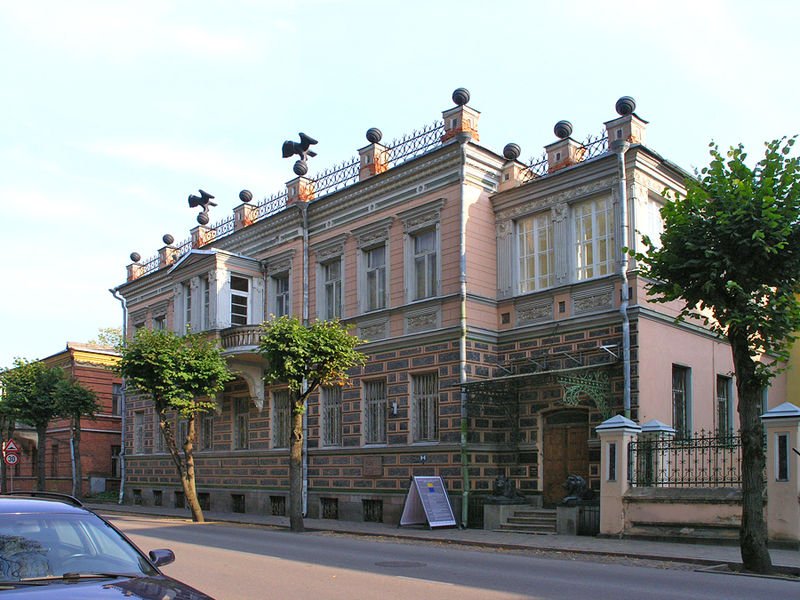 Daugavpils Museum
Daugavpils MuseumSource: https://commons.wikimedia.org/wiki/File:Daugavpils_museum.jpg
Author: Anatolyvyalikh

Daugavpils (Estonian: Väinalinn, Lithuanian: Daugpilis, Finnish: Väinänlinna, Polish: Dyneburg, Russian: Даугавпилс, Belarusian: Даўгаўпілс, Yiddish: דענעבורג) is the second biggest city in Latvia. It covers 72.48 sq km (28 sq mi) and has a population of 102,000.
Daugavpils is located on the southeastern part of Latvia, just 25 km from Lithuania and 33 km from Belarus. It experiences a moderate continental climate. July is the warmest month here, with average high temperature of 22.5°C (72.5°F). January is very cold, with average low temperature of -9.7°C (14.5°F). July is the wettest month, receiving 79 mm (3.11 in) of precipitation.
The history of Daugavpils goes back to 1275, when Dünaburg Castle was built. A settlement developed around the castle, 20 km away from the site of present-day Daugavpils. It was within the Livonian Confederation until 1561, when it became part of the Polish-Lithuanian Commonwealth.
 Evangelical Lutheran Church of Martin Luther
Evangelical Lutheran Church of Martin LutherSource: https://commons.wikimedia.org/wiki/File:Daugavpils_Evangelical_Lutheran_church_of_Martin_Luther12.JPG
Author: Alma Pater

In 1577, Düneburg Castle was captured and destroyed by Russian forces under tsar Ivan the Terrible. The people then relocated 20 km downriver, and built a new castle, Daugava Castle, which in Latvian is Daugavpils. The present city developed around this castle. The town was captured by Russians during the Russo-Swedish War (1656-1658), and for 11 years was under Russian occupation. During that time, it was called Borisglebsk (Борисоглебск).
Daugavpils had a sizable Jewish community from 1784 until the Second World War, when the Jewish population was decimated by the Nazis. Daugavpils was part of the Soviet Union under 1989, when the disintegration of the Soviet republic helped Latvia regain its independence. On 16 April, 2010, the vice mayor of Daugavpils was shot dead in the city center. The crime remained unsolved.
 Roman Catholic Church of Immaculate Conception, Daugavpils
Roman Catholic Church of Immaculate Conception, DaugavpilsSource: https://commons.wikimedia.org/wiki/File:Daugavpils_Immaculate_Conception_Roman_Catholic_Church13.JPG
Author: Alma Pater

Visiting Daugavpils
There are four trains connecting Daugavpils with Riga. There are also trains there from Vilnius and Saint Petersburg. You can also reach Daugavpils by bus from Riga, a journey of about three and a half hours.Places of Interest in Daugavpils
- Cathedral of Saints Boris and Glebe
This is the largest Russian Orthodox cathedral in Latvia. It is painted blue and white, and topped with ten golden cupolas. - Daugavpils Fortress
This is a fortress built during the Russian rule of the city in 1810. Its construction was interrrupted by the invasion staged by Napoleon in 1812. - Martin Luther Church
Church built in 1893, once used as a gym during the Soviet era. - Museum of Regional Studies and Arts
Museum showcasing local history as well as the paintings of Daugavpils-born artist Mark Rothko. - St Mary's Church
Rose-colored church topped with a small blue dome. - Synagogue
One of the remaining synagogues in Daugavpils, out of some 48 before the Second World War. It was restored with the help of the children of Daugavpils-born artist Mark Rothko. - Virgin Mary Catholic Church
Church built on the spot where, according to legend, the daughters of a rich local merchant drowned.
 Latest updates on Penang Travel Tips
Latest updates on Penang Travel Tips

Copyright © 2003-2025 Timothy Tye. All Rights Reserved.

 Go Back
Go Back